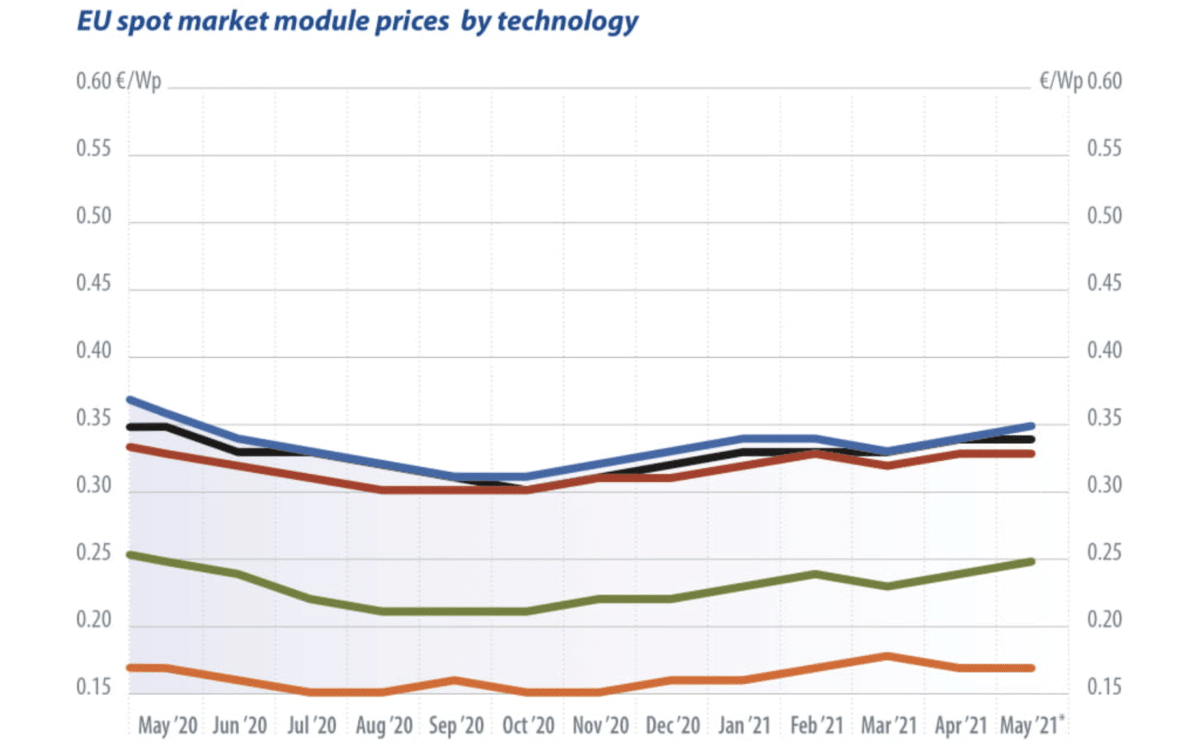From pv magazine 06/2021
A constitutional complaint against Germany’s short-sighted climate protection effort has forced policymakers to improve their plans in recent weeks. But there is a fear that in the years ahead, politicians in Germany and elsewhere will lack the creativity to present anything other than nuclear energy as the best, or only, solution that can be implemented in enough time to make a difference.
Solar is demonstrably the most economical form of energy generation.Unfortunately, we are still struggling with a shortage of materials across the board, starting with polysilicon for cell production, and precious metals, glass, and aluminum for module production. Added to this is a shortage of components for inverters, steel for substructures, and copper for cables. Freight rates from China are also rising on an almost daily basis. These factors are causing module prices and the overall cost of PV systems to skyrocket. However, a turnaround by the spring of 2022 at the latest is a realistic possibility.
German goals
Following a constitutional complaint by climate activists, including those from the Fridays For Future movement, the Federal Constitutional Court declared parts of the Climate Protection Act unconstitutional due to failure to provide sufficient emissions reductions from 2031 onwards.
According to the court ruling, future generations must not be left with a situation that restricts their freedoms and fundamental rights. The response was swift, probably with a view to the upcoming election. Instead of achieving climate neutrality by 2050, Germany is now set to be climate-neutral by 2045, and the target for greenhouse gas reduction by 2030 has been bumped up from 55% to 65%. Climate experts warn that the targets are still not enough to limit global warming to 1.5 C, yet some are already saying that all this will be far too expensive and will deal a mortal blow to Germany as a commercial location – same old story.
With the gradual decommissioning of Germany’s nuclear fleet, there has been more talk of an expected “electricity gap” that cannot be filled with renewables, only with natural gas. In any case, all reduction scenarios include some mention of greenhouse gas sequestration and storage; that is, technical or natural processes to remove CO2 from the atmosphere and permanently store it. After all, the climate law uses the misleading term “climate neutrality” and not “zero emissions” or “100% renewable energy generation.” But we are being led to believe that there are offsetting options which on closer inspection prove unrealistic. And the technical removal of carbon from the air with subsequent storage in underground reservoirs, so-called CO2 sequestration, is neither safe nor energetically feasible.
The success of the German activist legal action will probably inspire imitators around the world to file similar lawsuits. This is good, but in my opinion there is a danger that nuclear will be presented as a stopgap solution. Thankfully, a constitutional appeal would also be filed if nuclear expansion plans revive, since the radioactive waste also represents a burden imposed on future generations.
Nuclear renaissance
Even today, the reactors at Chernobyl and Fukushima are a threat. From Chernobyl, worrying incidents occur in the bowels of the containment structure created around the plant. And in Fukushima, the release of huge quantities of contaminated cooling water into the sea threatens to unleash another environmental catastrophe.
Meanwhile, sun and wind have been used to generate energy for over 30 years without major incident. When these plants are decommissioned, only valuable raw materials remain, which can be recycled increasingly well. There are some protests from those who feel inconvenienced by the close proximity of wind farms. But compared to nuclear, these are new technologies, and refinement can only make them more efficient and inconspicuous.
To take the wind out of the sails of nuclear power, we must accelerate the expansion of renewables at least twice the current speed. This means removing obstacles to onshore wind farms, and creating new incentives for private expansion. This need not, however, increase feed-in tariffs, which would only justify higher turbine prices and allow some manufacturers to maximize profits. Rather, implement more intelligent support measures such as tax breaks, scraping levies for operators, and genuine industry support for the establishment of local manufacturers. After all, if materials don’t have to be transported around the world, a lot of CO2 can be saved – and the products can be offered more cheaply to boot.
About the author
Martin Schachinger has been active in renewable energy for more than 20 years. In 2004, he founded the online trading platform pvXchange.com, where wholesalers, installers, and service companies can purchase standard components, solar modules, and inverters that are no longer manufactured, but are still urgently needed to repair defective PV systems.
This content is protected by copyright and may not be reused. If you want to cooperate with us and would like to reuse some of our content, please contact: editors@pv-magazine.com.



By submitting this form you agree to pv magazine using your data for the purposes of publishing your comment.
Your personal data will only be disclosed or otherwise transmitted to third parties for the purposes of spam filtering or if this is necessary for technical maintenance of the website. Any other transfer to third parties will not take place unless this is justified on the basis of applicable data protection regulations or if pv magazine is legally obliged to do so.
You may revoke this consent at any time with effect for the future, in which case your personal data will be deleted immediately. Otherwise, your data will be deleted if pv magazine has processed your request or the purpose of data storage is fulfilled.
Further information on data privacy can be found in our Data Protection Policy.